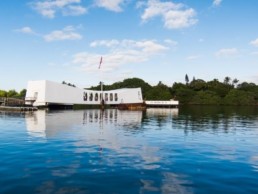“A Date Which Will Live In Infamy”: Remembering Pearl Harbor
December 7th marks the 75th anniversary of the attacks on Pearl Harbor. The two hour sneak attack by the Japanese left nearly 20 American naval vessels and more than 300 airplanes destroyed. Over 2,000 lives were lost and another 1,000 American soldiers and sailors were left injured. Three days later, after Congress approved President Franklin D. Roosevelt’s request to wage war on Japan, the United States joined other nations in World War II.
Much has changed for America since that day, but the feelings that survivors have about that day have not changed. Earl Brandes, Ed Guthrie, and Lawrence Osterbuhr were stationed in Honolulu the day Pearl Harbor was attacked. Now, 75 years later, all three men are back in their home state of Nebraska–Brandes is 95, Guthrie is 97, and Osterbuhr is 96.
“We’re really comrades,” Brandes said. “There’s not too many people left our age.” The three men used to be part of the Pearl Harbor Survivors Association, Nebraska chapter, but the group disbanded after December 2011 after the national organization decided there were too few members around to warrant a group. Since the group’s disbandment, the Sons and Daughters of Pearl Harbor Survivors, a group started in 1958, has helped to preserve the memory of those who served during the attack. “The Sons & Daughters wanted to make sure nobody forgot about Pearl Harbor,” Peg Murphy, Ed Guthrie’s daughter and the leader of the Nebraska chapter of the Sons & Daughters said.
Donald Stratton, another Pearl Harbor survivor from Red Cloud, Nebraska remembered the attack when he was a Seaman 1st Class aboard the USS Arizona. He and 1,177 shipmates managed to escape the Arizona for a neighboring ship and were spared during the attack. Stratton is now 94 years old, residing in Colorado Springs.
“The morning of Dec. 7, 1941, seemed like any other. We worked out a little bit and ate chow. I grabbed a few oranges to bring to a buddy of mine who was in the sick bay. Then I walked out onto the deck and saw some sailors congregating on the ship’s starboard side. They were looking across the water at Ford Island, an islet in the center of Pearl Harbor, and they were hollering — planes with the Japanese Zero insignia were banking through the sky.‘Oh, hell, it’s the Japanese!’ somebody shouted. ‘They’re bombing the water tower on Ford Island.’ We watched the tower fall and planes on the runway over there burst into flames,” Stratton said.
Across the nation, December 7th is a national day of remembrance. In El Paso, Colorado, Jim Downing was made a member of the El Paso County Commissioners just as a commemoration announcement for Pearl Harbor Day was announced. “My message to this generation: You are the leaders, you are the taxpayers, you are the voters, you are the legislators. Weakness invites aggression; keep America strong,” Downing said. “I want to keep America so strong that no adversary will ever think of attacking us.” Downing is one of the oldest living survivors at 103 years old.
In Hawaii, the war memorials for the attack are alive and thriving. This December 7th, people from all backgrounds will stand on Kilo Pier with the USS Arizona Memorial behind them to remember what happened. At the memorial, visitors can see pieces of metal from the downed ship in the water. The metal is still wet with oil that continuously leaks from the ship 75 years later. In addition, Hangar 79 at the Pacific Aviation Museum holds artifacts recovered from the site.
December 7, 1941 was a day of great loss for our country. It entered us into a war and the pain of the attack is still felt by survivors today. Now, we remember those who lost their lives in service to our country and try to keep their memory alive.
On December 7th, and every day, we remember the great sacrifice our soldiers and sailors made. The Purple Heart Foundation is committed to assisting veterans in all aspects of their lives, including helping those who are in need of assistance while transitioning home from the battlefield. You can show your support for these brave men and women who have sacrificed so much for our country by making a one-time or monthly pledge to ensure veterans continue to get the support and benefits they deserve by clicking here.
Sgt. Dorsey: The wallet that saved my life!
On Aug. 14, 1937, Mrs. Elizabeth Dorsey gave her youngest son, Raymond, a leather wallet as a present on his 16th birthday; she never knew that wallet would save her son’s life in WWII.
Raymond Dorsey joined the 22nd Infantry of the 4th ID a few weeks before Christmas. “We were in the Hürtgen Forest of Germany during the Battle of the Bulge. There was lots of snow, and it was so cold the soldiers had to take socks and other clothing off the dead to keep warm” – these memories still haunt Mr. Dorsey to this day.
“If it wasn’t the Germans trying to kill us it was the weather. I fought through the Bulge until mid-January of ’45 when it was over. This is when the prisoners started turning themselves in – they were glad to be out of it. There were more of them than there were of us, but the fighting was over, and they were surrendering. Middle of Jan ’45 – my outfit started to receive a lot of German prisoners. I had to line them up and search them. They all had a wallet full of German money, which was worthless to them now – there was nothing for them to buy, nowhere they could spend it – but I didn’t have any money. I traded them anything I could give them for their money. I ended up with so much of their money – my wallet was so full I couldn’t carry it in my back pocket, like normal, so I moved it to my shirt front pocket. We took artillery fire during the fighting at the Bulge and up until this time I had several close calls – yet was never hit.
We were later moved to the city of Prüm, Germany, on Feb 14, 1945 – we were told to set up a staging area at the edge of town. The enemy was waiting to hit us until the late evening; dropping shells all around us. We had to set up a command post in a house with two medics setup in the basement. I was on guard duty when the Germans dropped a shell real close. I was a little way away from the house and hadn’t been hit, so after those shells dropped, I moved closer to the house to find some cover. I took one step into the house and when I turned around a shell landed right in front of me… and that’s when my lights went out. The fat leather wallet in my shirt pocket, now over my heart, caught the main hit of shrapnel. I was unconscious and the medics helped save me by stopping the bleeding.
When I came to, I was on the floor of a big building, maybe an airplane hangar. From what I could see, the whole floor was covered with soldiers like myself – just full of soldiers like me. I wanted a drink of water – they wouldn’t give it to me, but they did give me a shot of morphine. I hadn’t had a shave or bath since I’d arrived. I must have been a sight! I don’t know how long I was there or where it was – they kept me knocked out. They loaded me into an ambulance, and I remember I heard them say we were passing the Eiffel Tower, so we must have been in Paris at this time. When I woke up next – I woke up bathed, shaved and in a clean bed with sheets. I don’t know how long I was in France. All I remember next is waking up in a hospital in England and being handed my belongings, the wallet included; only this time it was full of American money – someone had changed all the German money for American! I felt blessed because there was enough money in my wallet to send $100 to my wife (which was a lot of money in 1945) and I kept the rest.
My right thigh was all bandaged up and they started to unwrap it. They later rolled me outside for a long way to the operating room – that’s when they sewed up my leg wound and put it in a cast. When the cast was removed, my doctor came around and asked, “how are you doing today soldier?” I said “well, they just removed my cast, but I can’t move my knee.” He went to the bottom of my bed, grabbed my right foot and gave it a heave – like a pistol shot, you could hear it – but after that I could bend my knee again. I can still see shrapnel in my thigh, my ankle and I’ve got a little in my face around my left eye. My buddies in the hospital though were the ones to point out there was a hole in my wallet, that’s when I realized that the wallet my mother gave me on my 16th birthday is what saved my life that night in Germany!”
Sgt. Dorsey was never able to tell his mom that she had saved his life with her birthday gift. When he was medically fit to be sent home, he learned his mother was terminally ill. Sgt. Dorsey told us “I was able to see my mom just before she passed, as I’d finally been released – she was a good mother. I didn’t talk to her about the war, never showed the wounds; it was too soon, and people didn’t want to know. I still have to live with it.”
Veterans and Purple Heart recipients like Sgt. Dorsey did not only help shape history, they carry their own part of history with them, just waiting to impart their stories, experiences and wisdom on others. The next time you come across a veteran, take a moment to listen and you may be amazed at the incredibly heroic, selfless, and in cases like this…miraculous stories that nobody else knows about. One VA Center nurse took the time to not only listen to her patient, but to send the Purple Heart Foundation a written recount of Sgt. Dorsey’s story to share with all of you! Join us in saluting Mr. Dorsey for his service and sacrifice!
The Purple Heart Foundation provides various programs and assistance that supports our veterans and their families. The Purple Heart Foundation is committed to assisting veterans, and their caregivers, in all aspects of their lives, including helping those who need assistance while transitioning from the battlefield to the home front. You can show your support for these brave men and women who have sacrificed so much for our country by making a one-time or monthly pledge to ensure veterans continue to get the support and benefits they deserve.


